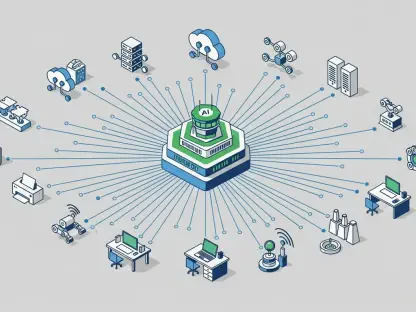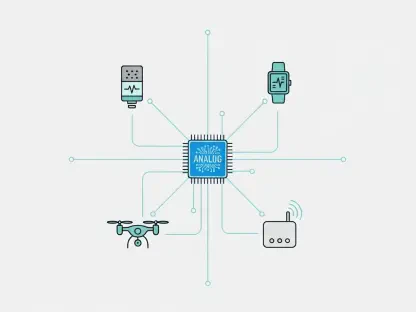In an era where technology evolves at an unprecedented pace, machine learning (ML) stands out as a transformative force that has fundamentally reshaped industries by 2025, moving far beyond a speculative idea or niche tool to become an integral part of operational frameworks across sectors like healthcare, retail, finance, logistics, agriculture, and energy. Its ability to turn raw data into actionable insights is no longer just a competitive advantage but a baseline expectation for businesses aiming to thrive. From compact, efficient models to ethically grounded systems, the trends driving ML today focus on making advanced technology accessible, practical, and trustworthy. This article delves into the pivotal developments that are not only pushing the boundaries of innovation but also ensuring that these advancements benefit a wide array of stakeholders. By examining the real-world applications and implications of these trends, a clearer picture emerges of how ML is redefining efficiency and problem-solving on a global scale.
Efficiency Through Smarter Models
The move toward smaller, smarter ML models marks a significant shift in how technology is deployed across industries in 2025. Unlike the resource-heavy systems of earlier years, today’s models leverage techniques like compression and quantization to deliver high performance with minimal hardware demands. This evolution has opened doors for smaller organizations and public entities to adopt ML without the burden of exorbitant costs. Hospitals, for instance, now use portable imaging systems powered by these compact models to diagnose conditions swiftly, while small financial firms employ anomaly detection to safeguard transactions. The democratization of such tools ensures that cutting-edge technology isn’t reserved for tech giants but is accessible to diverse players, fostering inclusivity and innovation at every level. This trend reflects a broader push to balance power with practicality, ensuring that ML solutions can scale without overwhelming resources or budgets in varied operational contexts.
Another dimension of this efficiency trend lies in how these streamlined models are tailored to specific industry needs, amplifying their impact. In education, for example, compact ML algorithms power personalized learning platforms that adapt to student progress without requiring vast server farms. Similarly, in agriculture, lightweight models embedded in handheld devices help farmers analyze soil health on-site, enabling quick decisions about irrigation or fertilization. This adaptability underscores the value of designing ML systems that prioritize functionality over sheer size, proving that bigger isn’t always better. By focusing on targeted applications, developers are crafting solutions that address real pain points rather than showcasing technological prowess for its own sake. As a result, industries previously sidelined by cost barriers are now active participants in the ML revolution, driving localized progress with global implications for productivity and growth.
Edge AI: Localized Intelligence
Edge AI represents a groundbreaking trend in 2025 by shifting data processing from remote cloud servers to local devices, enhancing speed and security across multiple sectors. This approach minimizes latency, slashes operational expenses, and protects sensitive information by keeping data on-site. In the automotive industry, vehicles equipped with edge AI analyze road conditions in real time to improve safety features like collision avoidance. Retailers, meanwhile, utilize smart shelves that instantly update inventory without cloud dependency, ensuring seamless store operations. This localized intelligence empowers businesses to react swiftly to dynamic environments, a critical advantage in fast-paced markets. Beyond efficiency, the reduced reliance on constant internet connectivity makes edge AI a viable solution for remote or underserved areas, broadening the reach of advanced technology to previously inaccessible regions.
The privacy benefits of edge AI further solidify its transformative potential, particularly in industries handling sensitive data. In healthcare, wearable devices process patient vitals directly on the device, safeguarding personal health information from potential cloud breaches. Similarly, in agriculture, edge-enabled tools identify crop issues without transmitting data externally, protecting farmers’ proprietary insights. This trend also cuts down on bandwidth costs, as massive data transfers to central servers become unnecessary, allowing companies to allocate resources elsewhere. The immediacy of on-device processing ensures that decisions—whether adjusting a factory machine or rerouting a delivery truck—are made without delay, directly boosting operational agility. As edge AI continues to mature, its role in creating resilient, self-sufficient systems becomes increasingly evident, reshaping how industries manage both data and real-time challenges with unmatched precision.
Multimodal AI: Integrating Diverse Data
Multimodal generative AI is redefining the capabilities of machine learning in 2025 by seamlessly blending various data types—text, audio, video, and sensor inputs—into cohesive outputs. This advancement moves beyond single-mode processing to create more nuanced and context-aware applications, particularly in creative and analytical fields. In media production, algorithms can transform written scripts into fully rendered video drafts, streamlining content creation. Healthcare benefits from systems that compile comprehensive patient profiles by integrating scans, voice recordings, and clinical notes, leading to more accurate diagnoses. This ability to synthesize disparate information into meaningful results is paving the way for richer interactions between humans and technology, enhancing both productivity and user experience across diverse domains.
Education is another area where multimodal AI shines, offering adaptive learning environments that respond to a student’s verbal cues and physical gestures. Tutoring systems can now assess not just answers but also tone and body language to gauge understanding, tailoring lessons accordingly. In customer service, businesses deploy AI that interprets text chats alongside vocal inflections during calls, providing more empathetic and effective responses. This trend highlights a shift toward holistic AI systems capable of mimicking human-like comprehension, bridging gaps that single-input models could not address. By processing and generating outputs from multiple sources simultaneously, multimodal AI fosters innovation in how industries solve complex problems, from designing interactive training modules to predicting consumer behavior with greater depth. The result is a technological landscape where machines don’t just react but truly engage with the intricacies of human communication.
Autonomous Agents: Redefining Collaboration
The emergence of autonomous AI agents in 2025 signifies a leap from static tools to dynamic collaborators that independently manage intricate tasks. These agents excel at multi-step processes, freeing up human resources for higher-level thinking. In logistics, they automatically adjust shipping routes based on traffic or weather data, ensuring timely deliveries with minimal oversight. For personal productivity, virtual assistants powered by autonomous AI handle scheduling, research, and even preliminary decision-making, acting as executive aides. This shift redefines workplace dynamics by positioning AI as a teammate rather than a mere utility, allowing employees to focus on strategy and creativity while routine operations are managed seamlessly.
Beyond operational efficiency, autonomous agents are transforming how industries approach scalability and adaptability in unpredictable environments. In manufacturing, these systems monitor production lines, predict equipment failures, and reorder supplies without human prompts, maintaining uninterrupted workflows. In finance, they execute real-time portfolio adjustments based on market shifts, reducing risks and maximizing returns. The key advantage lies in their ability to learn and adapt over time, refining their actions with each interaction to better align with organizational goals. This trend challenges the notion that automation equates to job displacement, instead illustrating how AI can augment human potential by handling repetitive or data-intensive tasks. As autonomous agents become more sophisticated, their integration into daily operations signals a future where collaboration between humans and machines drives unprecedented levels of innovation.
Ethical AI: Trust as a Cornerstone
In 2025, the emphasis on responsible AI and regulatory compliance has become a defining trend, ensuring that machine learning systems operate with transparency and fairness. Governments across the globe are implementing stringent guidelines that require industries to justify AI-driven decisions, particularly in high-stakes areas like banking, healthcare, and retail. Loan approval algorithms must now disclose their reasoning, medical diagnostics need validation for accuracy, and customer tracking systems are held accountable for privacy standards. Far from stifling progress, these regulations cultivate public confidence, encouraging wider adoption of ML technologies. Ethical AI is increasingly seen as a market differentiator, where companies prioritizing accountability gain a competitive edge over those lagging in compliance.
The push for trust extends beyond legal mandates to influence how businesses design and deploy ML systems. In healthcare, providers are adopting frameworks that allow patients to understand how diagnostic tools reach conclusions, fostering informed consent. Retailers, similarly, are transparent about how recommendation engines use personal data, reassuring customers about privacy protections. This focus on explainability ensures that AI isn’t perceived as a mysterious black box but as a reliable partner in decision-making. Moreover, the trend drives innovation in developing bias-mitigation techniques, ensuring algorithms don’t perpetuate inequities in areas like hiring or lending. By aligning technological advancement with societal values, responsible AI not only addresses current ethical concerns but also lays a foundation for sustainable growth, proving that trust is as critical as functionality in shaping the future of machine learning.
Sector-Specific Transformations
Machine learning’s impact in 2025 is vividly illustrated through its tailored applications across various industries, each benefiting from customized solutions. In healthcare, compact models accelerate diagnostics, while multimodal data integration personalizes treatment plans, with innovations like brainwave mapping aiding mental health recovery. Retail transforms through smart shelves that optimize inventory and AI-driven chat support that enhances customer interactions. Finance sees bolstered security via real-time fraud detection, cutting losses and building trust. These sector-specific advancements demonstrate ML’s versatility, showing that its value lies in addressing unique challenges rather than offering generic fixes, thereby driving measurable improvements in efficiency and outcomes.
Logistics also reaps significant benefits, with ML optimizing routes and predicting maintenance needs to reduce downtime and emissions. Agriculture leverages AI in drones and soil analysis for precision farming, boosting yields while conserving resources. The energy sector employs predictive tools for grid balancing and turbine monitoring, minimizing outages and supporting sustainability goals. Each application reflects a deep integration of ML into core operations, tailored to the distinct demands of the field. This adaptability ensures that industries aren’t just adopting technology for the sake of modernity but are solving longstanding issues with data-driven precision. As ML continues to evolve, its role as a catalyst for sector-specific progress becomes undeniable, reshaping economic landscapes one solution at a time.
Navigating a Balanced Technological Future
Reflecting on the strides made by 2025, machine learning has established itself as a cornerstone of industrial and societal advancement. The journey saw efficiency-driven models and edge AI breaking down barriers to access, while multimodal systems and autonomous agents expanded the scope of what technology could achieve. Regulatory frameworks have instilled a culture of accountability, ensuring that innovation does not outpace ethical considerations. Looking ahead, the focus should shift toward refining these integrations, prioritizing interoperability among systems to maximize impact. Industries must continue investing in talent and infrastructure to sustain this momentum, while policymakers should adapt regulations to emerging challenges without stifling creativity. By fostering collaboration between technologists, businesses, and regulators, the next phase of ML can build on past achievements, driving solutions that are as inclusive as they are groundbreaking.









